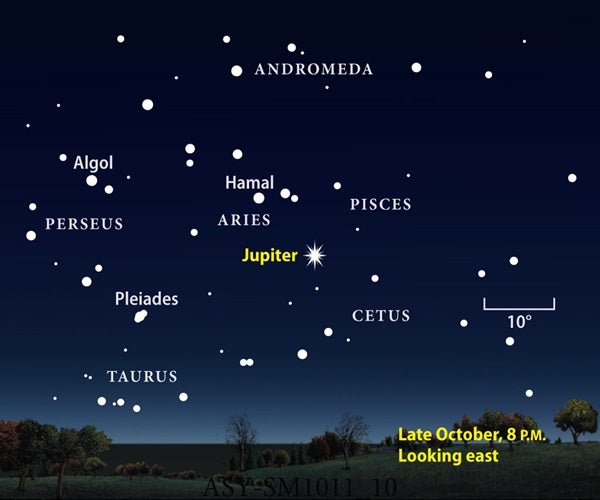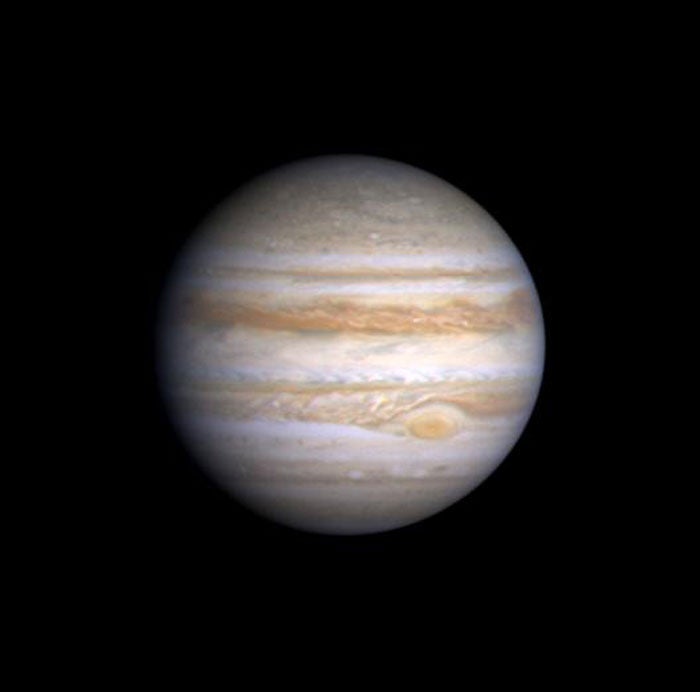The largest planet in the solar system, Jupiter, reaches maximum brightness the night of October 28. On that date, the planet lies opposite the Sun from Earth in our sky — this is called opposition. Jupiter will rise at sunset, appear highest around local midnight, and set as the Sun rises.
The king of planets will glow at magnitude −2.9, far brighter than any other point of light in the sky. The gas giant currently lies in Aries the Ram and is about 100 times more brilliant than the brightest star in that constellation. “Look for Jupiter in the east at sunset,” says Senior Editor Richard Talcott. “It will climb higher in the southeastern sky as the night wears on.”
You can observe Jupiter’s disk through any size telescope, which makes the planet a great target for beginners. You’ll be able to spot its dark equatorial cloud belts and even its four major moons, which align with Jupiter’s equator. The planet’s South Equatorial Belt returned in November 2010 after it mysteriously faded away for about six months.
At opposition, the planet’s disk will span 49.7″ across its equator but 46.5″ through the poles. This difference is because the planet is gaseous and spins rapidly, thus squashing its shape.
Fast facts about Jupiter
- Jupiter is the largest planet in the solar system. More than 1,300 Earths could fit inside it, and all the other planets together make up only about 70 percent of Jupiter’s volume.
- It takes Jupiter about 12 years to orbit the Sun once, but only about 10 hours to rotate completely, making it the fastest-spinning of all the solar system’s planets.
- Jupiter rotates so rapidly that its polar diameter, 83,082 miles (133,708 kilometers), is only 93 percent of its equatorial diameter, 88,846 miles (142,984 km).
- Jupiter reflects 52 percent of the sunlight falling on it, more than any other planet except Venus (65 percent).
- Jupiter’s four large moons — Io, Europa, Ganymede, and Callisto — are easily visible through small telescopes. Io takes less than two days to orbit its plamet, so its relative position visibly changes in an hour or so — less when it appears close to Jupiter.
- Our line of sight lies in the plane of the jovian moons’ orbits, so we see occultations (when a moon moves behind Jupiter), eclipses (when Jupiter’s shadow falls on a moon), and transits (when a moon passes in front of Jupiter) at various times.
- Jupiter’s moon Ganymede is the solar system’s largest satellite, with a diameter of nearly 3,300 miles (5,300 km), which is greater than that of Mercury.
- Video: Easy-to-find objects in the 2011 autumn sky, with Michael E. Bakich, senior editor
- StarDome: Locate Jupiter in your night sky with our interactive star chart.
- October’s Sky this Month: Glorious Jupiter reigns all night
- Sign up for our free weekly e-mail newsletter.












